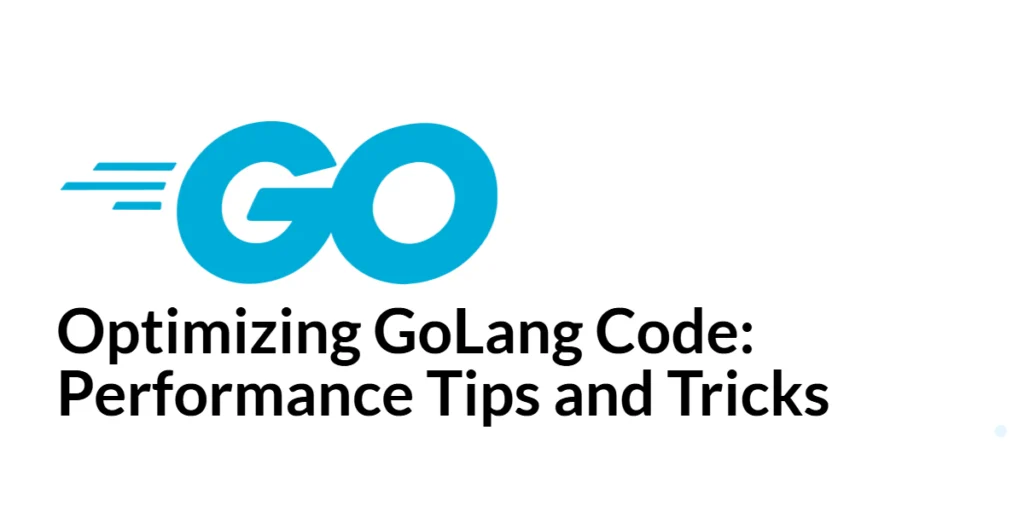Optimizing GoLang code is crucial for developing high-performance applications that can handle large-scale operations efficiently. Performance optimization involves analyzing and improving the execution speed, memory usage, and overall efficiency of your code. By identifying bottlenecks and applying targeted optimizations, you can significantly enhance your application’s performance.

with hands-on learning.
get the skills and confidence to land your next move.
GoLang, known for its simplicity and performance, provides various tools and techniques to help developers write optimized code. This guide will explore several tips and tricks for optimizing GoLang code, covering profiling, efficient use of goroutines, memory management, data structures, and more. Whether you’re building web services, data processing pipelines, or real-time systems, these techniques will help you maximize the performance of your GoLang applications.
Profiling and Benchmarking
Profiling with pprof
Profiling is the process of measuring the performance characteristics of your application to identify bottlenecks and areas for improvement. GoLang’s pprof package provides a robust toolset for profiling CPU and memory usage.
To use pprof, you need to import the package and start the profiling:
package main
import (
"log"
"net/http"
_ "net/http/pprof"
)
func main() {
// Start pprof server in a separate goroutine
go func() {
log.Println("Starting pprof server on http://localhost:6060")
if err := http.ListenAndServe("localhost:6060", nil); err != nil {
log.Fatalf("pprof server failed: %v", err)
}
}()
// Your application code here
log.Println("Application started successfully")
// Block indefinitely to keep the application running
select {}
}In this example, pprof is set up to listen on port 6060. You can access the profiling data by navigating to http://localhost:6060/debug/pprof/ in your browser. Use tools like go tool pprof to analyze the collected data and visualize hotspots in your code.
Benchmarking with testing
Benchmarking measures the performance of specific functions or code segments. The testing package in GoLang provides built-in support for benchmarking.
Here is an example of a simple benchmark:
package main
import (
"testing"
)
func Sum(a, b int) int {
return a + b
}
func BenchmarkSum(b *testing.B) {
for i := 0; i < b.N; i++ {
Sum(1, 2)
}
}To run the benchmark, use the following command:
go test -bench=.This command runs the benchmark and provides performance metrics, such as the number of operations per second and the time taken for each operation.
Efficient Use of Goroutines
Managing Goroutine Lifecycle
Goroutines are lightweight concurrent functions in Go, but their improper management can lead to resource leaks and performance issues. Always ensure goroutines are properly managed and terminated when no longer needed.
Here is an example of using a context to manage goroutine lifecycle:
package main
import (
"context"
"fmt"
"time"
)
func worker(ctx context.Context) {
for {
select {
case <-ctx.Done():
fmt.Println("Worker stopped")
return
default:
fmt.Println("Worker running")
time.Sleep(500 * time.Millisecond)
}
}
}
func main() {
ctx, cancel := context.WithCancel(context.Background())
go worker(ctx)
time.Sleep(2 * time.Second)
cancel()
time.Sleep(1 * time.Second)
}In this example, a context is used to cancel the goroutine, ensuring it stops gracefully.
Using Worker Pools
Worker pools help manage a large number of goroutines efficiently by reusing a fixed number of workers to process tasks.
Here is an example of a simple worker pool:
package main
import (
"fmt"
"sync"
)
func worker(id int, jobs <-chan int, wg *sync.WaitGroup) {
defer wg.Done()
for job := range jobs {
fmt.Printf("Worker %d processing job %d\n", id, job)
}
}
func main() {
const numWorkers = 3
jobs := make(chan int, 10)
var wg sync.WaitGroup
for i := 1; i <= numWorkers; i++ {
wg.Add(1)
go worker(i, jobs, &wg)
}
for j := 1; j <= 9; j++ {
jobs <- j
}
close(jobs)
wg.Wait()
}In this example, a fixed number of workers process jobs from a channel, ensuring efficient use of goroutines.
Memory Management
Reducing Allocations
Minimizing memory allocations can significantly improve performance. Use slices and maps efficiently, and avoid unnecessary allocations.
Here is an example of preallocating a slice:
package main
import "fmt"
func main() {
data := make([]int, 0, 100)
for i := 0; i < 100; i++ {
data = append(data, i)
}
fmt.Println(data)
}By preallocating the slice with a capacity of 100, we reduce the number of allocations during the append operations.
Using Sync.Pool
sync.Pool provides a way to reuse allocated objects, reducing the pressure on the garbage collector and improving performance.
Here is an example of using sync.Pool:
package main
import (
"fmt"
"sync"
)
var pool = sync.Pool{
New: func() interface{} {
return make([]byte, 1024)
},
}
func main() {
data := pool.Get().([]byte)
fmt.Println(len(data))
pool.Put(data)
}In this example, sync.Pool is used to manage a pool of byte slices, reducing the need for frequent allocations and deallocations.
Optimizing Loops and Functions
Loop Unrolling
Loop unrolling can improve performance by reducing the overhead of loop control. However, it should be used judiciously, as it can increase code size.
Here is an example of loop unrolling:
package main
import "fmt"
func main() {
data := []int{1, 2, 3, 4, 5}
sum := 0
for i := 0; i < len(data); i += 2 {
sum += data[i]
if i+1 < len(data) {
sum += data[i+1]
}
}
fmt.Println("Sum:", sum)
}In this example, the loop is unrolled to process two elements per iteration, reducing loop control overhead.
Function Inlining
Function inlining eliminates the overhead of function calls by embedding the function’s body directly into the caller.
Here is an example of a simple inlineable function:
package main
import "fmt"
func add(a, b int) int {
return a + b
}
func main() {
sum := add(1, 2)
fmt.Println("Sum:", sum)
}In this example, the add function is simple enough that the compiler may inline it, improving performance by avoiding the function call overhead.
Data Structures and Algorithms
Choosing the Right Data Structures
Selecting the appropriate data structures can have a significant impact on performance. Use slices, maps, and other structures judiciously based on their performance characteristics.
Here is an example of using a map for fast lookups:
package main
import "fmt"
func main() {
data := map[string]int{
"apple": 1,
"banana": 2,
"cherry": 3,
}
value, exists := data["banana"]
if exists {
fmt.Println("Value:", value)
}
}In this example, a map is used for fast key-value lookups, providing O(1) average time complexity.
Implementing Efficient Algorithms
Efficient algorithms can dramatically improve performance. Always consider the time and space complexity of your algorithms.
Here is an example of using a more efficient algorithm for finding the maximum value in a slice:
package main
import "fmt"
func max(data []int) int {
maxValue := data[0]
for _, v := range data {
if v > maxValue {
maxValue = v
}
}
return maxValue
}
func main() {
data := []int{3, 1, 4, 1, 5, 9, 2, 6, 5}
fmt.Println("Max value:", max(data))
}In this example, a simple linear scan is used to find the maximum value in the slice, providing O(n) time complexity.
I/O Performance
Buffered I/O
Buffered I/O can significantly improve performance by
reducing the number of system calls.
Here is an example of using buffered I/O:
package main
import (
"bufio"
"fmt"
"os"
)
func main() {
file, err := os.Open("data.txt")
if err != nil {
fmt.Println("Error:", err)
return
}
defer file.Close()
scanner := bufio.NewScanner(file)
for scanner.Scan() {
fmt.Println(scanner.Text())
}
if err := scanner.Err(); err != nil {
fmt.Println("Error:", err)
}
}In this example, bufio.NewScanner is used to read the file line by line efficiently.
Concurrent I/O
Concurrent I/O can further improve performance by allowing multiple I/O operations to proceed simultaneously.
Here is an example of concurrent I/O using goroutines:
package main
import (
"fmt"
"os"
"sync"
)
func readFile(filename string, wg *sync.WaitGroup) {
defer wg.Done()
data, err := os.ReadFile(filename)
if err != nil {
fmt.Println("Error:", err)
return
}
fmt.Println("File data:", string(data))
}
func main() {
var wg sync.WaitGroup
files := []string{"file1.txt", "file2.txt", "file3.txt"}
for _, file := range files {
wg.Add(1)
go readFile(file, &wg)
}
wg.Wait()
}In this example, multiple files are read concurrently using goroutines, improving I/O performance.
Leveraging Concurrency
Channels vs Mutexes
Channels and mutexes are both synchronization primitives in Go. Choose the right one based on the specific use case.
Here is an example of using a channel for communication:
package main
import (
"fmt"
)
func worker(id int, jobs <-chan int, results chan<- int) {
for job := range jobs {
results <- job * 2
}
}
func main() {
jobs := make(chan int, 5)
results := make(chan int, 5)
for w := 1; w <= 3; w++ {
go worker(w, jobs, results)
}
for j := 1; j <= 5; j++ {
jobs <- j
}
close(jobs)
for a := 1; a <= 5; a++ {
fmt.Println("Result:", <-results)
}
}In this example, a channel is used for communication between the main function and worker goroutines.
Avoiding Deadlocks
Avoiding deadlocks is crucial for maintaining the performance and correctness of concurrent programs. Always ensure that goroutines do not wait indefinitely for each other.
Here is an example of avoiding deadlocks:
package main
import (
"fmt"
"sync"
)
func main() {
var mu sync.Mutex
mu.Lock()
fmt.Println("Locked")
mu.Unlock()
fmt.Println("Unlocked")
}In this example, the mutex is properly locked and unlocked to avoid deadlocks.
Best Practices and Common Pitfalls
- Profile Before Optimizing: Always profile your code to identify actual bottlenecks before making optimizations.
- Keep It Simple: Avoid premature optimization and keep your code simple and readable.
- Minimize Global Variables: Global variables can lead to contention and performance issues.
- Use Defer Wisely: While
deferis convenient, it has a performance overhead. Use it judiciously. - Test Thoroughly: Ensure that optimizations do not introduce bugs or degrade performance in other areas.
Conclusion
Optimizing GoLang code involves a combination of profiling, efficient concurrency management, memory optimization, and choosing the right data structures and algorithms. By following the tips and tricks outlined in this guide, you can significantly enhance the performance of your Go applications. Always remember to profile before optimizing and focus on writing clean, maintainable code.
Additional Resources
To further your understanding of optimizing GoLang code, consider exploring the following resources:
- Go Programming Language Documentation: The official documentation provides comprehensive information on GoLang. Go Documentation
- Practical Go: Practical tips and best practices for writing high-performance Go code. Practical Go
- Go by Example: Practical examples of GoLang features and optimizations. Go by Example
By leveraging these resources, you can deepen your knowledge of Go and enhance your ability to write optimized, high-performance applications.







